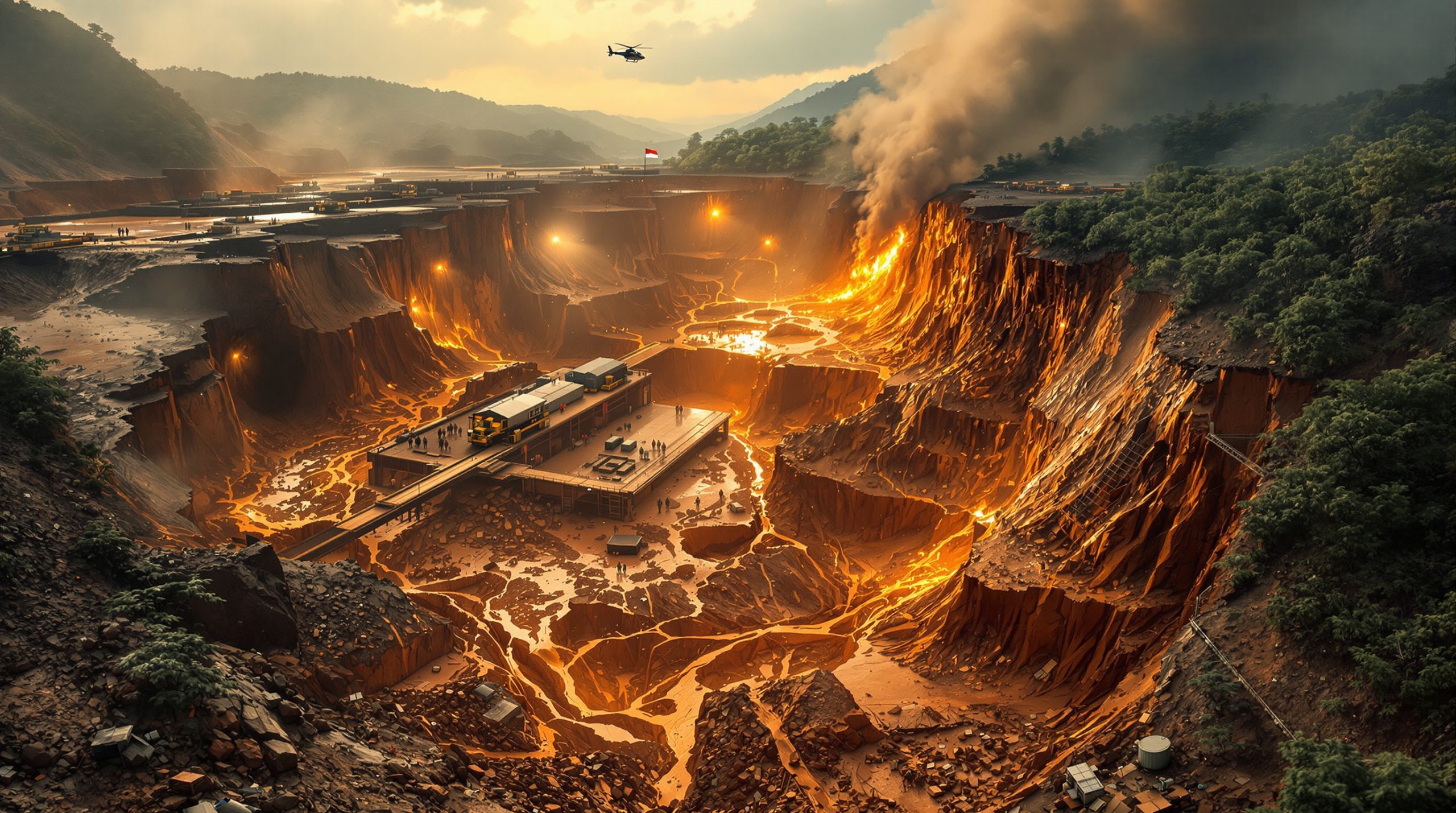What Are Orogenic Gold Deposits?
Understanding the Geological Context
Orogenic gold deposits represent one of Earth's most significant sources of gold mineralization in orogenic belts, forming during compressional to transpressional tectonic regimes typically associated with convergent plate boundaries. These deposits develop through complex interactions between hydrothermal fluids, structural controls, and host rock chemistry during mountain-building events.
These deposits form at depths of 5-15 km under greenschist to amphibolite facies metamorphic conditions, distinguishing them from shallower epithermal systems. The primary source of gold-bearing fluids comes from metamorphic devolatilization processes, where heated rocks release water, carbon dioxide, and dissolved metals during deep burial.
"Orogenic gold systems represent nature's most efficient metal concentrating mechanism, with fluids mobilizing gold across vast crustal volumes and depositing it in structurally favorable sites." — Dr. Richard Goldfarb, USGS (Goldfarb et al., 2005)
The timing of orogenic gold formation typically coincides with the later stages of orogeny, when deep-seated faults provide pathways for fluid migration from lower crustal or even mantle sources. These systems often show a remarkable temporal persistence, with some gold provinces remaining active for tens of millions of years.
The Economic Significance of Orogenic Gold Systems
Orogenic gold deposits account for approximately 30% of global gold production and 20% of total gold reserves worldwide. Their economic importance cannot be overstated, with individual deposits typically yielding between 1-100 million ounces of gold throughout their productive lifespans.
The largest orogenic gold system, Muruntau in Uzbekistan, contains an estimated resource exceeding 170 million ounces, making it the single largest gold deposit on Earth. Other notable examples include:
- The Yilgarn Craton deposits of Western Australia (>300 million ounces collectively)
- The Abitibi Greenstone Belt in Canada (>180 million ounces)
- The Ashanti Belt in Ghana (>120 million ounces)
These gold systems frequently form in clusters along major structural corridors, creating world-class mining districts that have supported multi-generational mining operations. The Kalgoorlie Super Pit in Australia, for example, has operated continuously since 1893, producing over 50 million ounces of gold to date.
Investment Perspective: Orogenic gold deposits typically offer lower capital costs for development compared to porphyry systems, with higher average grades (often >5 g/t) and extended mine lives exceeding 15-20 years for tier-one assets. The current record high gold prices make these deposits particularly attractive investment targets.
How Do Structural Controls Influence Gold Mineralization?
Fault Systems as Fluid Conduits
Major fault zones serve as the primary pathways for hydrothermal fluid migration in orogenic gold systems. These deep-seated structures, often extending to mid or lower crustal levels, provide the essential plumbing system that delivers gold-bearing fluids to potential deposition sites.
Research has shown that while major first-order faults channel the regional fluid flow, it's actually the second and third-order structures that typically host the richest mineralization. These subsidiary structures provide the ideal pressure-temperature conditions and chemical environments for efficient gold precipitation.
When examining potential orogenic gold environments, geologists should look for evidence of brittle deformation, including:
- Fault breccias (angular rock fragments cemented by quartz or carbonates)
- Slickensides (polished fault surfaces with linear striations)
- Clay gouge zones (crushed, clay-altered material along fault planes)
- Cataclasite bands (fine-grained, cohesive crushed rock)
Anastomosing fracture networks—interconnected, branching fracture systems—often indicate zones of enhanced permeability where gold-bearing fluids could concentrate. These networks commonly develop at dilational jogs or releasing bends along strike-slip fault systems.
Shear Zone Recognition
Shear zones represent zones of intense ductile deformation that accommodate strain through progressive deformation rather than discrete brittle failure. In orogenic gold systems, recognizing these zones is crucial as they frequently host significant gold mineralization in orogenic belts.
Key field indicators of shear zones include:
- Foliated rocks: Schists or mylonites with pronounced planar fabric
- S-C fabrics: Intersecting foliations indicating sense of shear
- Stretched or rotated mineral grains: Elongated quartz, feldspar, or porphyroblasts
- Boudinaged layers: Stretched and broken competent layers between less competent ones
Quartz veins within shear zones often appear parallel or subparallel to the shear foliation, frequently showing evidence of folding, boudinage, or transposition. The intensity of hydrothermal alteration typically increases within and adjacent to these shear corridors, creating visible halos around the principal deformation zones.
"The intersection of different generations of structures creates zones of enhanced permeability—these structural nodes are prime targets for high-grade gold mineralization." — Dr. Sarah Jones, Structural Geologist, Mineral Exploration Symposium 2023
Field geologists should carefully examine shear zones for evidence of multiple deformation events (overprinting relationships), as reactivated structures tend to be particularly favorable for gold deposition. The presence of different vein generations crosscutting each other often signals a long-lived hydrothermal system capable of concentrating significant gold.
Fold Structures as Mineralization Traps
Fold structures play a critical role in orogenic gold systems by creating zones of enhanced permeability and structural traps for mineralizing fluids. Gold frequently concentrates in fold hinges, especially where they intersect shear zones or major fault systems.
To identify these prospective structural settings, geologists should:
- Trace bedding and foliation orientations systematically to locate anticlines and synclines
- Measure fold axis plunges and axial plane orientations to determine fold geometry
- Focus attention on zones where fold axes are bent or kinked, creating areas of intense fracturing
- Examine fold limbs for evidence of flexural-slip movement (bedding-parallel faults)
The classical "saddle reef" deposits of Bendigo, Australia exemplify how fold structures can control gold mineralization. In this district, gold-quartz veins preferentially occupy the crests of anticlines, forming stacked ore bodies with remarkable vertical continuity exceeding 1,200 meters.
Fold-thrust stacks can create multiple horizons of potential mineralization where favorable lithologies are repeated by thrusting. This structural style characterizes the Val d'Or district in Quebec, where fold-related ore bodies occur at predictable structural positions within a sequence of thrust-stacked volcanic units.
Table: Structural Settings and Their Gold Potential
| Structural Setting | Relative Gold Potential | Example Deposits |
|---|---|---|
| Major fault zones | Moderate | Mother Lode, California |
| Second/third-order faults | High | Golden Mile, Australia |
| Shear zones | Very high | Ashanti Belt, Ghana |
| Fold hinges | High | Bendigo, Australia |
| Fault-fold intersections | Very high | Kirkland Lake, Canada |
| Dilational jogs | Very high | Kalgoorlie, Australia |
What Host Rock Characteristics Signal Potential Gold Mineralization?
Favorable Lithologies
Specific rock types consistently demonstrate enhanced potential for hosting orogenic gold mineralization due to their chemical reactivity, competency characteristics, or structural behavior during deformation. Understanding these lithological preferences provides critical targeting criteria for gold exploration drilling.
Metamorphosed volcanic rocks, particularly greenstones and basalts, represent classic hosts for orogenic gold systems worldwide. These mafic lithologies contain abundant iron-bearing minerals (magnetite, pyrite, chlorite) that effectively precipitate gold from hydrothermal solutions through reduction reactions. The Abitibi greenstone belt of Canada exemplifies this association, hosting world-class deposits like Kirkland Lake and Timmins.
Metasedimentary sequences also provide fertile ground for gold mineralization, including:
- Greywacke: Immature sandstones with rock fragments and feldspar
- Carbonaceous shale: Organic-rich fine-grained sediments that act as chemical reductants
- Banded iron formations: Chemically reactive iron-rich units
- Turbidite sequences: Alternating competent and incompetent layers creating structural traps
Iron-rich units play a particularly important role by promoting chemical precipitation of gold. When sulfur-bearing hydrothermal fluids interact with iron-rich rocks, the resulting sulfidation reactions destabilize gold-bisulfide complexes, causing gold to precipitate alongside iron sulfides. The massive Homestake deposit in South Dakota formed through this process, with gold mineralization hosted in iron formation.
Competency contrasts between adjacent rock units create structural traps where fluids can concentrate. The juxtaposition of rigid units (diorite, silicified sediments) against more ductile lithologies (shales, schists) creates zones of enhanced fracturing during deformation. These interfaces frequently host high-grade ore shoots, as exemplified by the Campbell-Red Lake deposit in Ontario.
Diagnostic Alteration Signatures
Hydrothermal alteration provides one of the most visible and extensive signatures of orogenic gold systems. Recognition of characteristic alteration assemblages allows geologists to vector toward potential mineralization, even when gold itself remains invisible.
Silicification represents the addition of silica (SiO₂) to host rocks, typically appearing as:
- Replacement of original minerals by microcrystalline quartz
- Development of harder, more resistant outcrops
- Lighter-colored zones with increased brittleness
- Preservation of primary textures as "ghosts" within silicified rock
Sericitization involves the formation of fine-grained white mica (sericite) through the hydrolysis of feldspars and other aluminosilicate minerals. Field indicators include:
- Soft, silky sheen on fracture surfaces
- Pale green to silvery-white alteration
- Rocks that feel soapy or talc-like when weathered
- Loss of original rock hardness and competency
Carbonatization results from the introduction of carbonate minerals (calcite, dolomite, ankerite) into the host rock. Look for:
- White to buff-colored patches and veinlets
- Effervescence when tested with dilute hydrochloric acid
- Distinctive tan to orange-brown weathering (especially with iron-bearing carbonates)
- Increased rock softness compared to unaltered equivalents
Sulfidation involves the addition of sulfide minerals, primarily pyrite and arsenopyrite, which appear as:
- Disseminated metallic grains throughout altered rock
- Cubic crystals (pyrite) or needle-like prisms (arsenopyrite)
- Rusty weathering on exposed surfaces
- Increased specific gravity in heavily sulfidized samples
"The zoned alteration footprint of orogenic gold systems can extend hundreds of meters beyond economic mineralization, providing a much larger target than the gold itself." — Dr. Tim Baker, Economic Geology, 2018
Field Recognition of Alteration Halos
Alteration halos surrounding gold mineralization typically display systematic zoning patterns that can guide exploration. Moving from distal to proximal zones (toward mineralization), the following progression is commonly observed:
- Distal zone: Weak carbonatization, background sulfide content
- Intermediate zone: Moderate sericitization, increased carbonate, appearance of pyrite
- Proximal zone: Strong silicification, intense sericitization, abundant sulfides
- Ore zone: Quartz veining, intense silicification, high sulfide content, visible gold
Color changes provide immediate visual cues to alteration, with rusty brown staining from oxidized pyrite being particularly conspicuous. This iron-oxide coloration often creates a "gossan" cap above sulfide-rich zones, visible from considerable distances in well-exposed terrain.
Textural modifications accompany chemical changes, with softening of rock due to sericite or carbonate alteration contrasting with hardening in silicified zones. These textural variations can be detected through simple scratch tests with a rock hammer or knife blade.
Alteration intensity typically increases toward mineralized structures, creating visible gradients that can vector toward ore. Systematic mapping of alteration assemblages and their intensities provides powerful directional indicators for exploration targeting. Recent gold market surge has renewed interest in mapping these alteration patterns in historic mining districts.
| Alteration Type | Proximal Indicator | Distal Indicator | Field Test |
|---|---|---|---|
| Silicification | Massive quartz replacement | Quartz veinlets, increased hardness | Scratch test, HCl non-reactive |
| Sericitization | Pervasive pale green alteration | Spotty white mica on fractures | Silky feel, softness |
| Carbonatization | Ankerite (Fe-carbonate) | Calcite veinlets | HCl reaction (effervescence) |
| Sulfidation | Arsenopyrite, coarse pyrite | Fine disseminated pyrite | Metallic luster, rusty weathering |
How Do Quartz Veins Reveal Gold Potential?
Diagnostic Vein Morphologies
Quartz veins represent the most visible expression of hydrothermal activity in orogenic gold systems. Their morphology provides critical insights into formation conditions and gold potential. Recognizing diagnostic vein types enables more effective targeting during exploration, which has become increasingly important with the rise of undervalued gold mining stocks.
Laminated (ribbon) veins consist of alternating bands of quartz separated by thin layers of wall rock or sulfides. These features indicate:
- Episodic fluid flow under fluctuating pressure conditions
- Multiple crack-seal cycles during progressive deformation
- Potential for gold concentration along the darker laminae
- Formation during active shearing
The world-class Bendigo goldfield in Australia showcases classic laminated veins, where gold concentrates along graphite-rich laminae within quartz.
Brecciated veins contain angular fragments of wall rock or earlier vein material cemented by later quartz. This texture signals:
- Sudden pressure fluctuations causing hydraulic fracturing
- Multiple fluid pulses entering the system
- Enhanced permeability promoting fluid-rock interaction
- Potential for higher gold grades due to efficient precipitation
The Giant Mine in Canada's Northwest Territories features spectacular brecciated veins where gold concentrates around wall rock fragments.
Stockwork systems comprise dense networks of intersecting veinlets that typically form in more competent rock units. These systems indicate:
- Brittle failure under high fluid pressures
- Three-dimensional fluid flow through interconnected fractures
- Potential for bulk-mineable, lower-grade mineralization
- Proximity to major fluid pathways
The Fort Knox deposit in Alaska exemplifies a stockwork-dominated orogenic system hosted in a granitic intrusion.
Massive tabular veins form thick planar structures along major shear zones or fault systems. These impressive features suggest:
- Long-lived, stable fluid conduits
- High fluid volumes passing through the system
- Potential for significant gold endowment
- Formation during periods of relative structural quiescence
The historic Mother Lode district of California contains massive tabular veins exceeding 10 meters in thickness with remarkable strike continuity.
Vein Textures and Internal Structures
Internal textures within quartz veins provide crucial information about formation conditions and gold potential. Recognizing these subtle features requires careful observation, preferably with a hand lens in the field.
Comb structures consist of quartz crystals growing perpendicular to vein walls, creating tooth-like projections. These textures indicate:
- Open-space filling under relatively stable conditions
- Growth into fluid-filled cavities
- Potential for fluid inclusion studies
- Lower deformation after vein formation
Vugs and cavities represent unfilled spaces within veins that may host euhedral mineral crystals. These features suggest:
- Fluid pressure less than lithostatic pressure
- Potential for late-stage mineral precipitation
- Possible sites for visible gold deposition
- Decreased stress during the final stages of vein formation
Crack-seal textures appear as parallel inclusion bands or trails within quartz, recording incremental vein opening. These textures reveal:
- Cyclic fracturing and mineral precipitation
- Active deformation during vein formation
- Favorable conditions for gold trapping
- Potential for multiple mineralization events
"The internal architecture of quartz veins records the deformation history and fluid pressure conditions during mineralization—these features are goldfingers pointing to the richest zones." — Dr. François Robert, Structural Controls on Hard Rock Gold Deposits
Ready to Spot the Next Major Gold Discovery?
Discover significant ASX mineral discoveries as they happen with Discovery Alert's proprietary Discovery IQ model, which transforms complex geological data into actionable investment insights. Explore why major gold discoveries can lead to exceptional market returns by visiting Discovery Alert's dedicated discoveries page and position yourself ahead of the market with your 30-day free trial.




